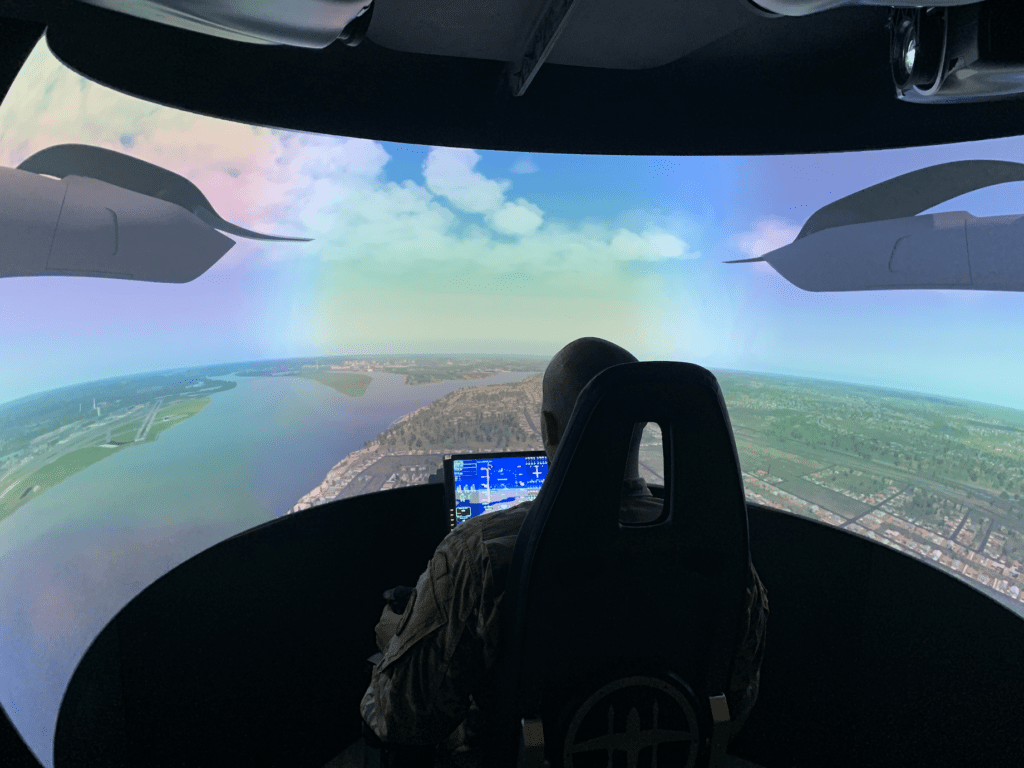Aptima Evaluates eVTOL Pilot Training Requirements Through USAF Contract


Aptima was awarded a contract from the U.S. Air Force to evaluate necessary skills and training for pilots of eVTOL aircraft. Aptima’s Dr. Samantha Emerson and Dr. Kent Halverson shared some insights on the progress they have made. Pictured above is a pilot flying an eVTOL simulator. (Photo provided by Port San Antonio)
The company Aptima revealed in August that it was awarded a contract from the U.S. Air Force to evaluate necessary skills and training for pilots of electric vertical take-off and landing (eVTOL) aircraft. Through this contract, Aptima has been assisting the Air Education and Training Command’s Detachment 62, which supports the AFWERX Agility Prime program. Det 62 is also responsible for developing the curriculum for operators of eVTOL aircraft.
To learn more about the progress Aptima has made so far, Avionics International recently caught up with the project manager for the contract, Dr. Samantha Emerson, and Dr. Kent Halverson, Principal Scientist and Senior Director of the Training, Learning, and Readiness Division at Aptima.
Det 62 first reached out to the team at Aptima for assistance in measuring pilot performance on eVTOL platforms, explained Dr. Halverson. “Aptima has been doing some of the performance measurements in the fast jet training simulation domain for decades,” he said. “We’ve built a suite of human performance measurement technologies that Detachment 62 is interested in leveraging.”
He added that the measurement of human performance has to change when considering vehicles like eVTOLs that will incorporate significant automation: “The pilot doesn’t have to do things that they used to have to do on traditional aircraft. It’s not always clear what the human’s doing and what the machine’s doing all by itself.”
Aptima’s team is testing the learnability of two eVTOL platforms through experimentation and analysis. “We’re especially interested in looking at learning trajectories,” explained Dr. Emerson, “to see how long it takes both pilots and people without experience to learn how to fly these things—or at least to learn basic stick and rudder skills.”
Another component of this project is evaluating differences in pilot skills for those who have experience operating either fixed-wing aircraft or rotorcraft. They are also evaluating how increased levels of automation and augmentation on the aircraft affect an individual’s performance.
Aptima’s team is also developing a human-machine teaming framework in order to systematically classify aspects of the flight as controlled by either a human agent or a machine.
Aptima is using its Performance Evaluation Training System (PETS) to gather objective data from the eVTOL simulators, as well as a handheld tool called SPOTLITE that subject matter experts utilize for measuring performance. These technologies have been developed in conjunction with the Air Force Research Laboratory (AFRL).

Aptima was awarded a contract by the U.S. Air Force to evaluate the requirements for eVTOL pilot training. (Photo: BETA Technologies)
Dr. Emerson remarked that Aptima has received criticism for focusing only on pilots’ stick and rudder skills and not looking at airmanship, ground operations, or emergency procedures. “For our experiment, we are only looking at performance-based learning trajectories of how pilots can actually maneuver the vehicles,” she noted. “We’re narrowly focused on how long it takes to learn to fly these things.”
For the experiment itself, students operated one of two different simulators to fly a predetermined route around the D.C. area. The student would repeat the same flight profile four times while a trained instructor pilot guided them along the route. The instructor would provide less and less guidance during each of the four repetitions.
“We measured how well they performed hovering, take-off, landings, and route navigation,” explained Dr. Emerson. “We had the instructor pilots rate them on each of those, and we pulled data on how well they were able to maintain a given altitude or given airspeed. We’re also working on examining how close they were to the ideal path, and how that changed over time, too.”
The researchers observed that pilots picked up the necessary skills quickly over the duration of the experiment—especially on the simulated aircraft with higher levels of automation.
The students without any previous pilot experience “didn’t achieve that same high level of performance but showed rapid gains over those two hours,” said Dr. Emerson.
“More levels of automation ended up bootstrapping the performance, but even in the vehicle with the more ‘conventional’ controls, two hours was plenty of time for the pilots to really show some significant gains—especially in route navigation and take-off,” she shared.
They observed much greater variability in hovering skills. Pilots with experience operating helicopters demonstrated an advantage over fixed-wing pilots while in the simulator with less automation and more conventional controls. However, “even fixed wing pilots were able to grasp it pretty quickly,” Dr. Emerson stated.
Dr. Halverson added, “Hovering a helicopter is a fairly difficult thing to learn how to do, because you have to monitor several different gauges and there are four or five different control surfaces that you’re managing. That’s a pretty heavy multitasking situation.”
Automation has the potential to make hovering a much less challenging task, and particularly for those without much piloting experience.
The post Aptima Evaluates eVTOL Pilot Training Requirements Through USAF Contract appeared first on Avionics International.
—————
Boost Internet Speed–
Free Business Hosting–
Free Email Account–
Dropcatch–
Free Secure Email–
Secure Email–
Cheap VOIP Calls–
Free Hosting–
Boost Inflight Wifi–
Premium Domains–
Free Domains





